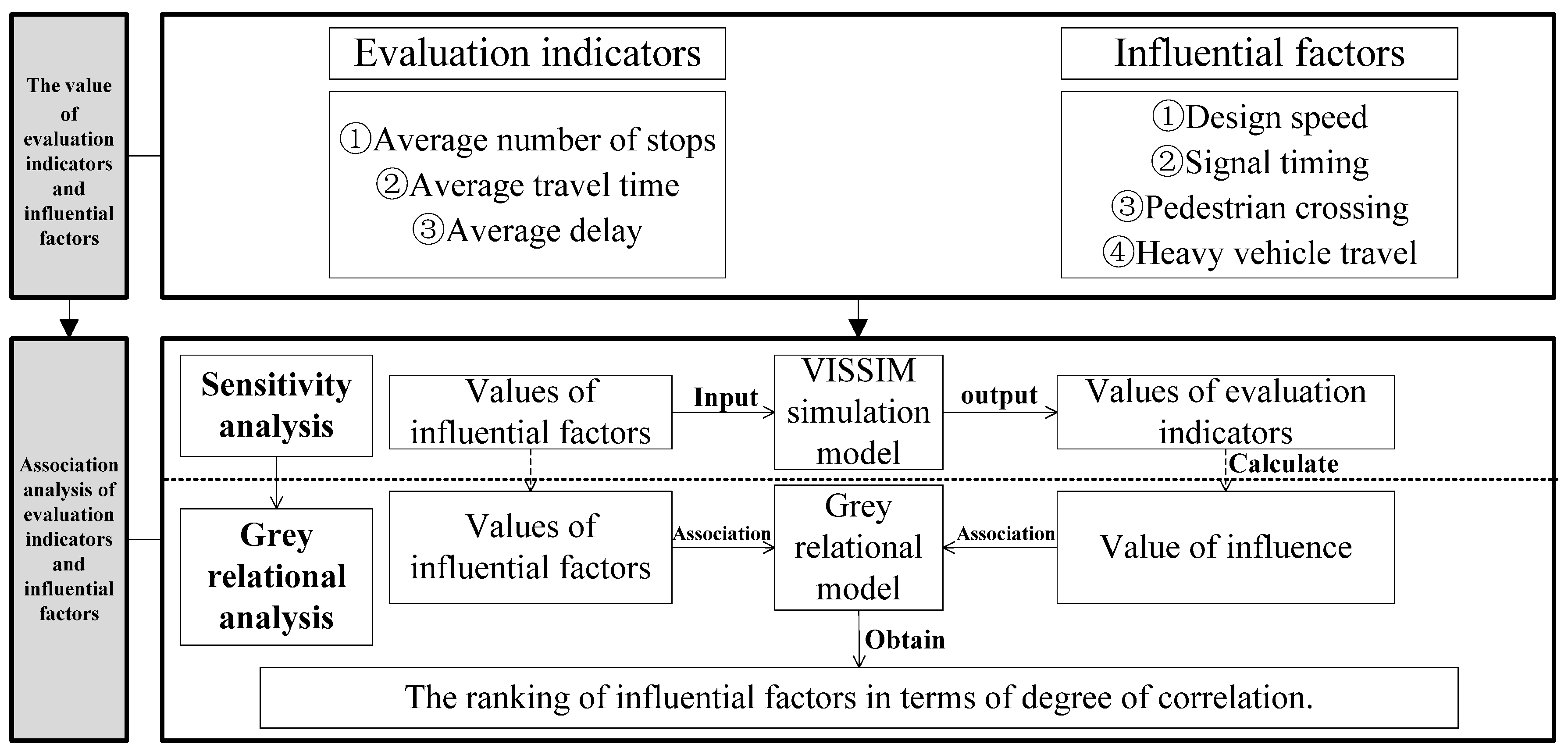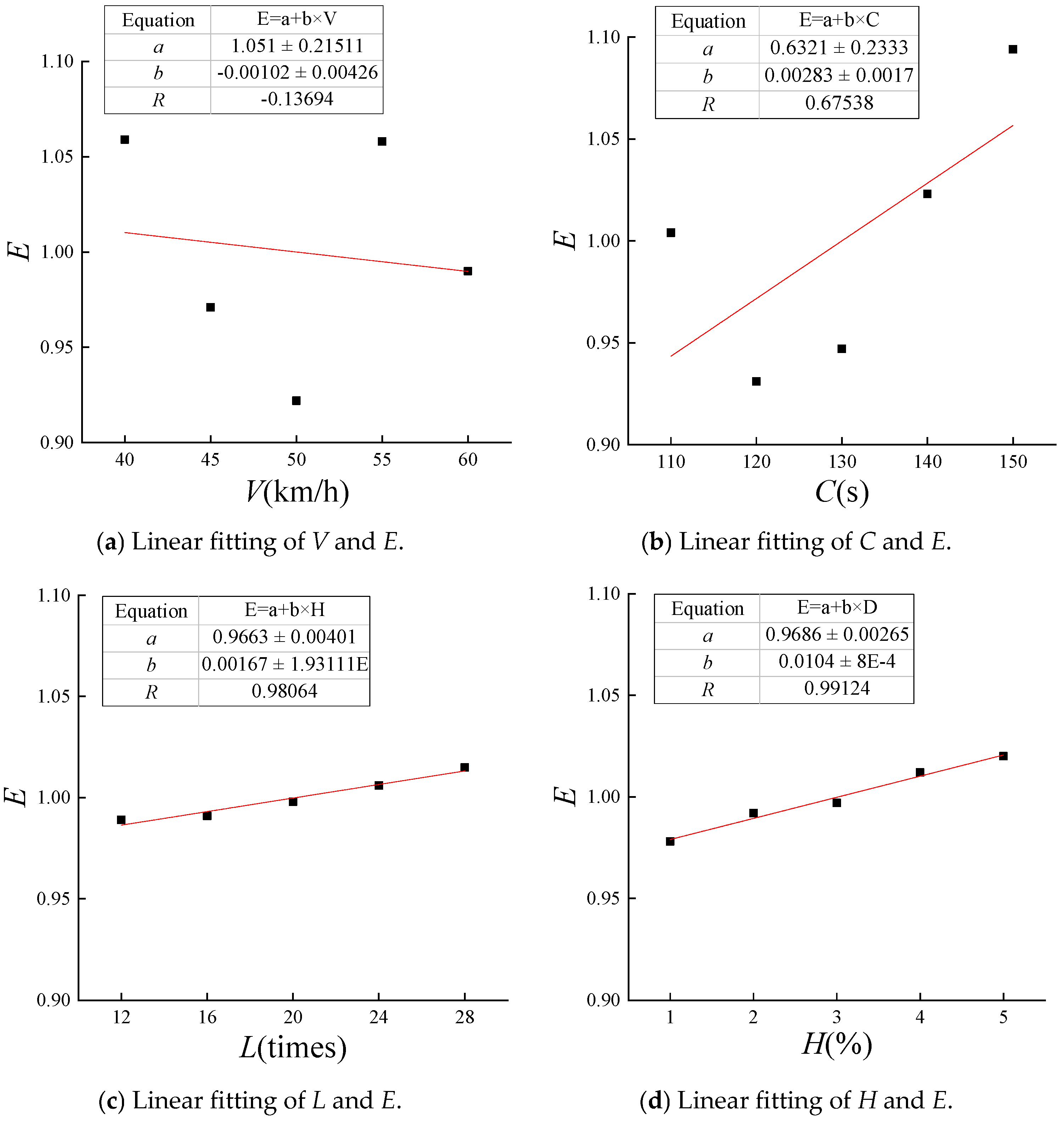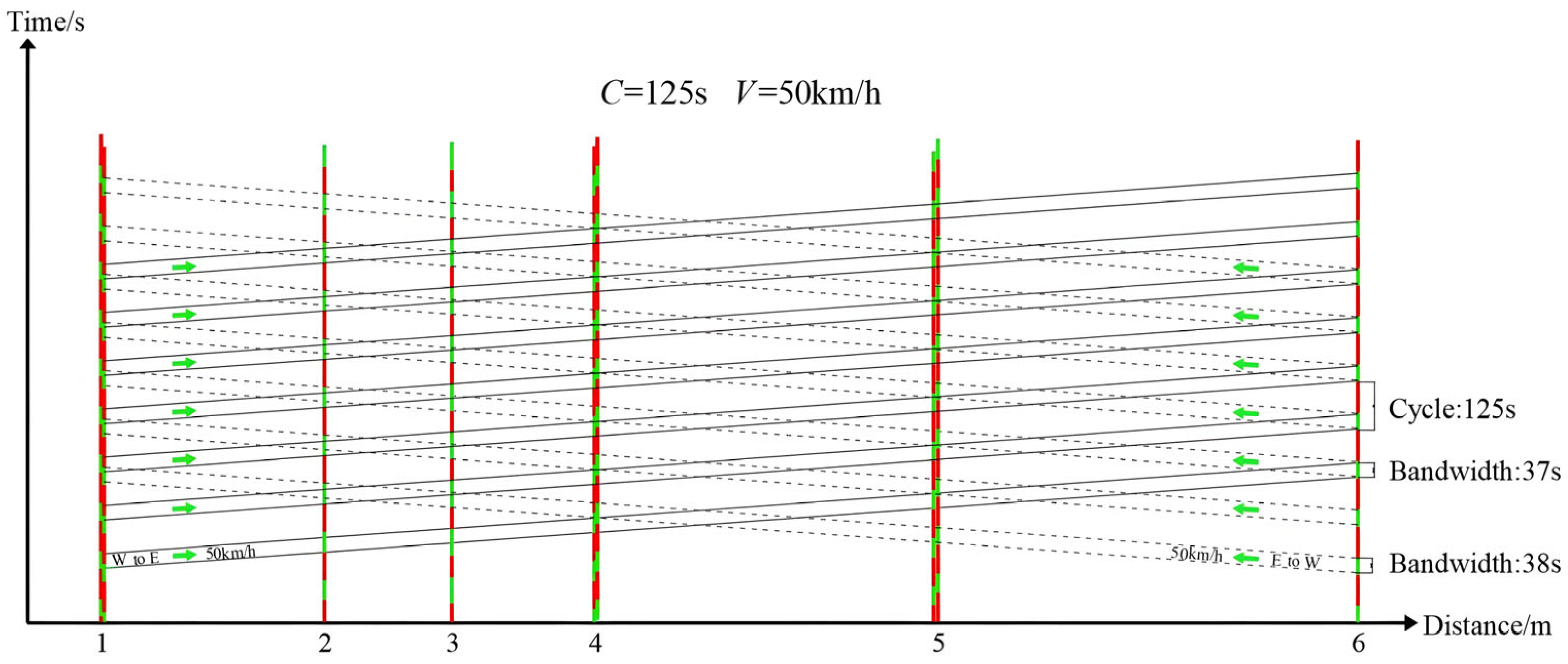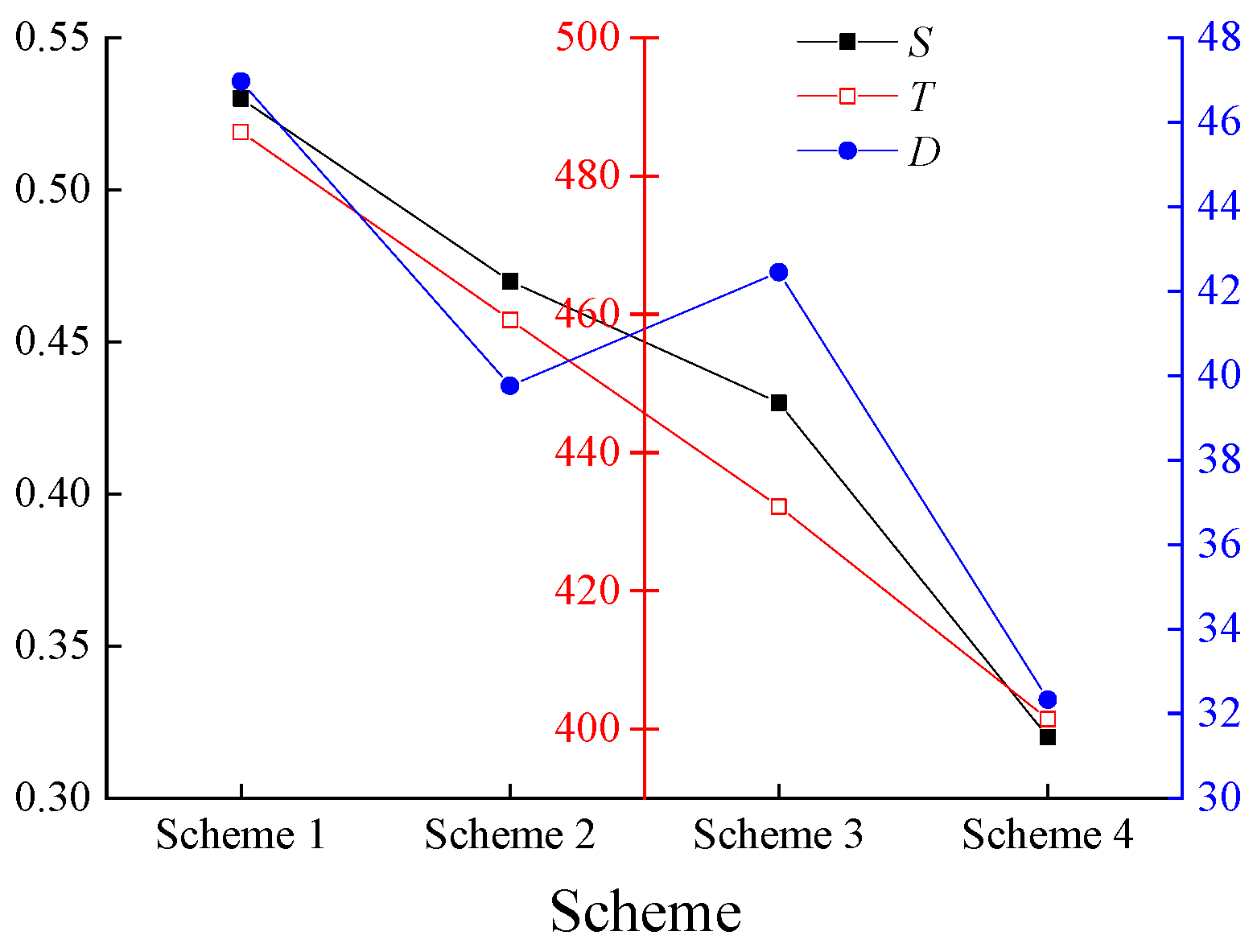Identification of Factors Influencing the Operational Effect of the Green Wave on Urban Arterial Roads Based on Association Analysis
Abstract
1. Introduction
2. Methods
2.1. General Idea
2.2. The Values of Evaluation Indicators and Influential Factors
2.2.1. The Values of Evaluation Indicators
- (1)
- Average number of stops
- (2)
- Average travel time
- (3)
- Average delay
2.2.2. The Values of Influential Factors
- (1)
- Design speed of the green wave
- (2)
- Signal timing scheme
- (3)
- Pedestrian crossing
- (4)
- Heavy vehicle traffic
2.3. Association Analysis of Evaluation Indicators and Influential Factors
2.3.1. Sensitivity Analysis of Influential Factors and Value of Influence
2.3.2. Grey Relational Analysis of Influential Factors and Value of Influence
3. Results
3.1. Data
3.1.1. Original Datasets
3.1.2. Data Matching
3.2. Association Analysis
3.2.1. Sensitivity Analysis
3.2.2. Grey Relational Analysis
3.3. Simulation-Based Verification
4. Discussion
4.1. Identification of Influential Factors
4.2. Effect of Different Optimization Measuress
5. Conclusions
Author Contributions
Funding
Data Availability Statement
Conflicts of Interest
References
- Ma, C.; He, R. Green wave traffic control system optimization based on adaptive genetic-artificial fish swarm algorithm. Neural Comput. Appl. 2019, 31, 2073–2083. [Google Scholar] [CrossRef]
- Lu, K.; Tian, X.; Jiang, S.; Xu, J.; Wang, Y. Optimization model for regional green wave coordinated control based on ring-and-barrier structure. J. Intell. Transp. Syst. 2022, 26, 68–80. [Google Scholar] [CrossRef]
- Yao, J.; Tang, Q.; Wang, P. A Multiroute Signal Control Model considering Coordination Rate of Green Bandwidth. J. Adv. Transp. 2021, 2021, e4310403. [Google Scholar] [CrossRef]
- Qu, D.Y.; Wan, M.F.; Wang, Z.L.; Xu, X.H.; Wang, J.Z. Green Wave Coordinate Control Method for Arterial Traffic Based on Traffic Wave Theory. J. Highw. Transp. Res. Dev. 2017, 11, 4. [Google Scholar] [CrossRef]
- Guo, H.Y.; Wang, J.S. Coordinated control and evaluation of traffic trunk lines. Shandong Jiaotong Keji 2021, 4, 102–105. [Google Scholar]
- Lin, Q.H.; Sun, X.F.; Hong, W.T. On the Control Effect Evaluation of Green Wave Coordination System of Urban Arteries. Munic. Eng. Technol. 2020, 38, 36–39. [Google Scholar] [CrossRef]
- Ji, L.; Cheng, W. Method of Bidirectional Green Wave Coordinated Control for Arterials under Asymmetric Release Mode. Electronics 2022, 11, 2846. [Google Scholar] [CrossRef]
- Zhang, J.; Zhang, J.; Zhu, Q.; Luo, Y.; Lv, F.; Gao, H. Optimization of Trunk Phase Difference for Seeking Maximum Bidirectional Green Wave Bandwidth. J. Phys. Conf. Ser. 2023, 2437, 012074. [Google Scholar] [CrossRef]
- Ma, Z.; Cui, T.; Deng, W.; Jiang, F.; Zhang, L. Adaptive Optimization of Traffic Signal Timing via Deep Reinforcement Learning. J. Adv. Transp. 2021, 2021, e6616702. [Google Scholar] [CrossRef]
- Chen, Z.M.; Liu, X.M.; Wu, W.X. Optimization Method of Intersection Signal Coordinated Control Based on Vehicle Actuated Model. Math. Probl. Eng. 2015, 2015, e749748. [Google Scholar] [CrossRef]
- Liang, Z.; Xiao, Y.; Flötteröd, Y.-P. An Overlapping Phase Approach to Optimize Bus Signal Priority Control under Two-Way Signal Coordination on Urban Arterials. J. Adv. Transp. 2021, 2021, e6624130. [Google Scholar] [CrossRef]
- Yu, L.; Hu, X. Study on control and optimization algorithm of dynamic green wave used in city traffic intelligent control. J. Intell. Fuzzy Syst. 2018, 35, 2785–2792. [Google Scholar] [CrossRef]
- Zheng, Y.; Guo, R.; Ma, D.; Zhao, Z.; Li, X. A Novel Approach to Coordinating Green Wave System With Adaptation Evolutionary Strategy. IEEE Access 2020, 8, 214115–214127. [Google Scholar] [CrossRef]
- Liu, X.M.; Wei, X.D.; Dong, L.X.; Shang, C.L. Evaluation of green wave coordinated control effect of trunk line based on vehicle trajectory data. J. Guilin Univ. Technol. 2022, 1, 1–11. [Google Scholar]
- Tian, Z.; Ohene, F.; Hu, P. Arterial Performance Evaluation on an Adaptive Traffic Signal Control System. Procedia-Soc. Behav. Sci. 2011, 16, 230–239. [Google Scholar] [CrossRef]
- Chia, I.; Wu, X.; Dhaliwal, S.S.; Thai, J.; Jia, X. Evaluation of Actuated, Coordinated, and Adaptive Signal Control Systems: A Case Study. J. Transp. Eng. Part A Syst. 2017, 143, 05017007. [Google Scholar] [CrossRef]
- Wang, H.; Miao, Q.; Zhang, Y.; Wen, X. Green Wave Zone Evaluation Method Based on Electronic Police Data. In Proceedings of the 2021 2nd International Conference on Big Data and Informatization Education (ICBDIE), Hangzhou, China, 2–4 April 2021; Volume 2021, pp. 155–158. [Google Scholar] [CrossRef]
- Ma, C.; Ao, G.C.; Shao, Y.M. Evaluation of Urban Arterial Road Traveling Efficiency in Signal Coordination Control. J. Transp. Inf. Saf. 2012, 30, 62–65. [Google Scholar]
- Zhuo, X.; Shi, W.R.; Qian, Z.D. Traffic evaluation method for urban arterial green wave coordination control system. J. Fuzhou Univ. Nat. Sci. Ed. 2015, 43, 369–376. [Google Scholar]
- Pan, Y.; Jia, S.P. A Two-way Green Wave Coordinated Control Model for Urban Arterial Line Considering Speed Fluctuation lnterval. Sci. Technol. Eng. 2019, 19, 336–342. [Google Scholar]
- Wang, Y.; Yang, X.; Liu, Y.; Liang, H. Evaluation and Application of Urban Traffic Signal Optimizing Control Strategy Based on Reinforcement Learning. J. Adv. Transp. 2018, 2018, e3631489. [Google Scholar] [CrossRef]
- Fan, Z.D.; LI, M.L.; Ran, J.; Zhang, Y. Construction of vehicle speed prediction model based on lateral interference degree and number of traffic accidents. Highw. Automot. Appl. 2021, 2, 34–36+42. [Google Scholar]
- Ci, Y.S.; Zheng, S.N.; Zhao, H.T. Empirical model of road segment vehicle delay based on numerical distribution of pedestrians’ crossing. J. Chongqing Jiaotong Univ. Nat. Sci. 2018, 37, 76–80. [Google Scholar]
- Ghanim, M.S.; Abu-Lebdeh, G. Characterization of heavy vehicle headways in oversaturated interrupted conditions: Towards development of passenger car equivalency factors. Int. J. Transp. Sci. Technol. 2019, 11, 589–602. [Google Scholar] [CrossRef]
- Miqdady, T.; de Oña, R.; de Oña, J. Traffic Safety Sensitivity Analysis of Parameters Used for Connected and Autonomous Vehicle Calibration. Sustainability 2023, 15, 9990. [Google Scholar] [CrossRef]
- Bouadi, M.; Jia, B.; Jiang, R.; Li, X.; Gao, Z. Optimizing sensitivity parameters of automated driving vehicles in an open heterogeneous traffic flow system. Transp. A Transp. Sci. 2022, 18, 762–806. [Google Scholar] [CrossRef]
- Wu, B.; Wang, X.Y.; Liu, T.; Dong, N.B.; Zhang, J.X.; Zhang, P. Identification of Traffic Accidents Causation in Rural-urban Fringe Based on Correlation Analysis. J. Wuhan Univ. Technol. Transp. Sci. Eng. 2022, 46, 948–952. [Google Scholar]
- Canbulut, G.; Köse, E.; Arik, O.A. Public transportation vehicle selection by the grey relational analysis method. Public Transp. 2022, 14, 367–384. [Google Scholar] [CrossRef]
- Li, W.; Zhao, X.; Liu, S. Traffic Accident Prediction Based on Multivariable Grey Model. Information 2020, 11, 184. [Google Scholar] [CrossRef]
- Liu, Y.; Huang, X.; Duan, J.; Zhang, H. The assessment of traffic accident risk based on grey relational analysis and fuzzy comprehensive evaluation method. Nat. Hazards 2017, 88, 1409–1422. [Google Scholar] [CrossRef]
- Zhang, T.; Cao, Y.G.; Zhao, Y.; Lin, L.L. The design and innovation of elevated station in the middle of Wuhu rail transit project. Railw. Stand. Des. 2023, 67, 109–116. [Google Scholar] [CrossRef]
- Wang, S.X.; Qiao, P.; Zhang, Z.Z.; Tan, X.Q.; Zhu, P. Difference research in quota consumption based on regression analysis ression analysis. J. Transp. Sci. Eng. 2010, 26, 19–22. [Google Scholar] [CrossRef]
- Jia, H.; Lin, Y.; Luo, Q.; Li, Y.; Miao, H. Multi-objective optimization of urban road intersection signal timing based on particle swarm optimization algorithm. Adv. Mech. Eng. 2019, 11, 1687814019842498. [Google Scholar] [CrossRef]
- Tajalli, M.; Mehrabipour, M.; Hajbabaie, A. Network-Level Coordinated Speed Optimization and Traffic Light Control for Connected and Automated Vehicles. IEEE Trans. Intell. Transp. Syst. 2021, 22, 6748–6759. [Google Scholar] [CrossRef]
- Zhang, J.; Shang, H.; Li, X.; Yao, Y. An integrated arterial coordinated control model considering green wave on branch roads and pedestrian crossing time at intersections. J. Manag. Sci. Eng. 2020, 5, 303–317. [Google Scholar] [CrossRef]
- Shelmakov, S.V.; Grigoreva, T.U. Methodology and examples for assessing the environmental performance of certain road traffic management measures. IOP Conf. Ser. Mater. Sci. Eng. 2021, 1159, 012039. [Google Scholar] [CrossRef]






| Intersection Number | Direction | License Plate | Vehicle Types | Recorded Time |
|---|---|---|---|---|
| 1 | East | *B2N13* | Small vehicle | 2020/9/21 08:47 |
| 1 | West | *A268H* | Small vehicle | 2020/9/21 08:47 |
| 1 | South | *B8549* | Small vehicle | 2020/9/21 08:47 |
| 1 | North | *A097A* | Heavy vehicle | 2020/9/21 08:47 |
| Intersection Number | Intersection Canalization | Green Wave Schemes | ||||||
|---|---|---|---|---|---|---|---|---|
| Direction | Turning Direction | Number of Lanes | V | C | Phase | Timing | Offset | |
| 1 | East | Left-turn | 2 | 50 km/h | 130 s |  | 37 | 114 s |
| East | Straight | 3 | ||||||
| West | Left-turn | 2 |  | 3 | ||||
| West | Straight | 3 | ||||||
| South | Left-turn | 2 |  | 37 | ||||
| South | Straight | 4 | ||||||
| North | Left-turn | 2 |  | 26 | ||||
| North | Straight | 4 |  | 27 | ||||
| Upstream Intersection Number | Downstream Intersection Number | Road Length (m) | Number of Non-Signal Crosswalks | Flow of Pedestrian Crossing (p/h) |
|---|---|---|---|---|
| 1 | 2 | 1300 | 0 | / |
| 2 | 3 | 800 | 0 | / |
| 3 | 4 | 900 | 0 | / |
| 4 | 5 | 1300 | 1 | 80 |
| 5 | 6 | 1500 | 2 | 230 |
| License Plate | Type of Vehicle | Upstream Intersection Number | Downstream Intersection Number | Road Length (m) | Starting Time | Ending Time |
|---|---|---|---|---|---|---|
| *PD0851* | Small vehicle | 1 | 2 | 1300 | 2020/9/21 08:50 | 2020/9/21 08:51 |
| *P5N512* | Small vehicle | 2 | 3 | 800 | 2020/9/21 08:51 | 2020/9/21 08:52 |
| *P28B96* | Small vehicle | 3 | 4 | 900 | 2020/9/21 08:46 | 2020/9/21 08:48 |
| *PD0209* | Small vehicle | 4 | 5 | 1300 | 2020/9/21 09:15 | 2020/9/21 09:17 |
| *PD0304* | Heavy vehicle | 5 | 6 | 1500 | 2020/9/21 09:28 | 2020/9/21 09:29 |
| Non-Signalled Crosswalks m | Pm (p/h) | k | |
|---|---|---|---|
| 7 | 1/3 | 80 | 20% |
| 8 | 1/3 | 145 | |
| 9 | 1/3 | 85 |
| Road (W to E) | ln (m) | Qnh (pcu/h) | Qn (pcu/h) | Road (E to W) | Qnh (pcu/h) | Qn (pcu/h) |
|---|---|---|---|---|---|---|
| 1–2 | 1300 | 0 | 314 | 6–5 | 45 | 1372 |
| 2–3 | 800 | 14 | 352 | 5–4 | 41 | 1268 |
| 3–4 | 900 | 55 | 969 | 4–3 | 2 | 137 |
| 4–5 | 1300 | 42 | 949 | 3–2 | 2 | 68 |
| 5–6 | 1500 | 38 | 928 | 2–1 | 41 | 769 |
| Schemes | V (km/h) | Schemes | C(s) | Schemes | L (Times) | Schemes | H (%) |
|---|---|---|---|---|---|---|---|
| A1 | 40 | B1 | 110 | C1 | 12 | D1 | 1 |
| A2 | 45 | B2 | 120 | C2 | 16 | D2 | 2 |
| A3 | 50 | B3 | 130 | C3 | 20 | D3 | 3 |
| A4 | 55 | B4 | 140 | C4 | 24 | D4 | 4 |
| A5 | 60 | B5 | 150 | C5 | 28 | D5 | 5 |
| Intersection | Phase | Timing | V | Offset | Bandwidth | V | Offset | Bandwidth | V | Offset | Bandwidth | V | Offset | Bandwidth | V | Offset | Bandwidth |
|---|---|---|---|---|---|---|---|---|---|---|---|---|---|---|---|---|---|
| 1 |  | 37 | 40 km/h | 60 | 12 | 45 km/h | 118 | 32.5 | 50 km/h | 114 | 35 | 55 km/h | 10 | 11.5 | 60 km/h | 28 | 14.5 |
 | 3 | ||||||||||||||||
 | 37 | ||||||||||||||||
 | 26 | ||||||||||||||||
 | 27 | ||||||||||||||||
| 2 |  | 39 | 0 | 68 | 64 | 62 | 99 | ||||||||||
 | 46 | ||||||||||||||||
 | 22 | ||||||||||||||||
 | 23 | ||||||||||||||||
| 3 |  | 30 | 49 | 51 | 49 | 106 | 119 | ||||||||||
 | 74 | ||||||||||||||||
 | 26 | ||||||||||||||||
| 4 |  | 26 | 59 | 120 | 117 | 117 | 123 | ||||||||||
 | 21 | ||||||||||||||||
 | 26 | ||||||||||||||||
 | 28 | ||||||||||||||||
 | 29 | ||||||||||||||||
| 5 |  | 29 | 31 | 56 | 50 | 46 | 46 | ||||||||||
 | 18 | ||||||||||||||||
 | 29 | ||||||||||||||||
 | 23 | ||||||||||||||||
 | 31 | ||||||||||||||||
| 6 |  | 47 | 0 | 0 | 0 | 0 | 0 | ||||||||||
 | 50 | ||||||||||||||||
 | 16 | ||||||||||||||||
 | 17 |
| Intersection | Phase | C | Timing | Offset | Bandwidth | C | Timing | Offset | Bandwidth | C | Timing | Offset | Bandwidth | C | Timing | Offset | Bandwidth | C | Timing | Offset | Bandwidth |
|---|---|---|---|---|---|---|---|---|---|---|---|---|---|---|---|---|---|---|---|---|---|
| 1 |  | 110 | 25 | 94 | 8.5 | 120 | 20 | 116 | 30 | 130 | 37 | 114 | 35 | 140 | 37 | 55 | 11.5 | 150 | 27 | 64 | 14.5 |
 | 8 | 16 | 3 | 8 | 23 | ||||||||||||||||
 | 25 | 20 | 37 | 37 | 27 | ||||||||||||||||
 | 25 | 29 | 26 | 29 | 33 | ||||||||||||||||
 | 27 | 35 | 27 | 29 | 40 | ||||||||||||||||
| 2 |  | 110 | 30 | 48 | 120 | 35 | 60 | 130 | 39 | 64 | 140 | 41 | 72 | 150 | 43 | 74 | |||||
 | 46 | 46 | 46 | 53 | 58 | ||||||||||||||||
 | 17 | 19 | 22 | 22 | 24 | ||||||||||||||||
 | 17 | 20 | 23 | 24 | 25 | ||||||||||||||||
| 3 |  | 110 | 25 | 34 | 120 | 25 | 50 | 130 | 30 | 49 | 140 | 29 | 128 | 150 | 31 | 135 | |||||
 | 56 | 67 | 74 | 79 | 84 | ||||||||||||||||
 | 29 | 28 | 26 | 32 | 35 | ||||||||||||||||
| 4 |  | 110 | 29 | 33 | 120 | 20 | 108 | 130 | 26 | 117 | 140 | 25 | 127 | 150 | 23 | 137 | |||||
 | 16 | 25 | 21 | 28 | 34 | ||||||||||||||||
 | 29 | 20 | 26 | 25 | 23 | ||||||||||||||||
 | 16 | 20 | 28 | 31 | 32 | ||||||||||||||||
 | 20 | 35 | 29 | 31 | 38 | ||||||||||||||||
| 5 |  | 110 | 28 | 30 | 120 | 25 | 50 | 130 | 29 | 50 | 140 | 21 | 59 | 150 | 21 | 53 | |||||
 | 15 | 20 | 18 | 37 | 39 | ||||||||||||||||
 | 28 | 25 | 29 | 21 | 21 | ||||||||||||||||
 | 16 | 20 | 23 | 25 | 30 | ||||||||||||||||
 | 23 | 30 | 31 | 36 | 39 | ||||||||||||||||
| 6 |  | 110 | 39 | 0 | 120 | 43 | 0 | 130 | 47 | 0 | 140 | 48 | 0 | 150 | 52 | 0 | |||||
 | 40 | 44 | 50 | 52 | 55 | ||||||||||||||||
 | 15 | 16 | 16 | 19 | 21 | ||||||||||||||||
 | 16 | 17 | 17 | 21 | 22 |
| Intersection Number | East | West | South | North | ||||
|---|---|---|---|---|---|---|---|---|
| Left-Turn | Straight | Left-Turn | Straight | Left-Turn | Straight | Left-Turn | Straight | |
 |  |  |  |  |  |  |  | |
| 1 | 392 | 608 | 432 | 622 | 206 | 264 | 156 | 205 |
| 2 | 184 | 919 | 335 | 403 | 126 | 235 | 164 | 165 |
| 3 | / | 423 | 300 | 1082 | / | / | 345 | / |
| 4 | 398 | 1285 | 286 | 1038 | 153 | 203 | 105 | 165 |
| 5 | 429 | 1502 | 91 | 1058 | 111 | 219 | 132 | 405 |
| 6 | 1147 | 1220 | 187 | 1161 | 154 | 109 | 176 | 237 |
| Schemes | V (km/h) | C (s) | L (times) | H (%) | S | T | D | E |
|---|---|---|---|---|---|---|---|---|
| A1 | 40 | 130 | 20 | 3 | 0.72 | 520.65 | 49.52 | 1.059 |
| A2 | 45 | 130 | 20 | 3 | 0.58 | 487.13 | 50.22 | 0.971 |
| A3 | 50 | 130 | 20 | 3 | 0.53 | 486.39 | 46.97 | 0.922 |
| A4 | 55 | 130 | 20 | 3 | 0.74 | 524.16 | 47.51 | 1.058 |
| A5 | 60 | 130 | 20 | 3 | 0.68 | 513.54 | 43.28 | 0.990 |
| B1 | 50 | 110 | 20 | 3 | 0.73 | 525.69 | 36.07 | 1.002 |
| B2 | 50 | 120 | 20 | 3 | 0.58 | 487.89 | 40.84 | 0.929 |
| B3 | 50 | 130 | 20 | 3 | 0.53 | 486.39 | 46.97 | 0.945 |
| B4 | 50 | 140 | 20 | 3 | 0.60 | 490.87 | 51.91 | 1.023 |
| B5 | 50 | 150 | 20 | 3 | 0.62 | 517.77 | 57.86 | 1.092 |
| C1 | 50 | 130 | 12 | 3 | 0.53 | 482.89 | 46.06 | 0.989 |
| C2 | 50 | 130 | 16 | 3 | 0.53 | 485.20 | 46.09 | 0.991 |
| C3 | 50 | 130 | 20 | 3 | 0.53 | 486.39 | 46.97 | 0.998 |
| C4 | 50 | 130 | 24 | 3 | 0.54 | 488.26 | 47.02 | 1.006 |
| C5 | 50 | 130 | 28 | 3 | 0.55 | 488.70 | 47.33 | 1.015 |
| D1 | 50 | 130 | 20 | 1 | 0.52 | 481.60 | 45.60 | 0.978 |
| D2 | 50 | 130 | 20 | 2 | 0.53 | 485.17 | 46.39 | 0.992 |
| D3 | 50 | 130 | 20 | 3 | 0.53 | 486.39 | 46.97 | 0.997 |
| D4 | 50 | 130 | 20 | 4 | 0.54 | 494.74 | 47.41 | 1.012 |
| D5 | 50 | 130 | 20 | 5 | 0.54 | 495.16 | 48.47 | 1.020 |
| Intersection 1 | Intersection 2 | Intersection 3 | Intersection 4 | Intersection 5 | Intersection 6 | ||||||
|---|---|---|---|---|---|---|---|---|---|---|---|
| Phase | Timing | Phase | Timing | Phase | Timing | Phase | Timing | Phase | Timing | Phase | Timing |
 | 34 |  | 31 |  | 26 |  | 25 |  | 33 |  | 45 |
 | 12 |  | 54 |  | 70 |  | 28 |  | 18 |  | 46 |
 | 34 |  | 19 |  | 29 |  | 25 |  | 33 |  | 15 |
 | 20 |  | 21 |  | 20 |  | 18 |  | 19 | ||
 | 25 |  | 27 |  | 23 | ||||||
| Offset | 108 | Offset | 59 | Offset | 50 | Offset | 109 | Offset | 54 | Offset | 0 |
| Simulation Schemes | V (km/h) | C (s) | L (times) | H (%) | S | T | D | E |
|---|---|---|---|---|---|---|---|---|
| Scheme 1 | 50 | 130 | 20 | 3 | 0.53 | 486.39 | 46.97 | 1.156 |
| Scheme 2 | 50 | 125 | 20 | 3 | 0.47 | 459.21 | 39.76 | 1.030 |
| Scheme 3 | 50 | 130 | 0 | 0 | 0.43 | 432.19 | 42.45 | 1.002 |
| Scheme 4 | 50 | 125 | 0 | 0 | 0.32 | 401.42 | 32.33 | 0.812 |
Disclaimer/Publisher’s Note: The statements, opinions and data contained in all publications are solely those of the individual author(s) and contributor(s) and not of MDPI and/or the editor(s). MDPI and/or the editor(s) disclaim responsibility for any injury to people or property resulting from any ideas, methods, instructions or products referred to in the content. |
© 2023 by the authors. Licensee MDPI, Basel, Switzerland. This article is an open access article distributed under the terms and conditions of the Creative Commons Attribution (CC BY) license (https://creativecommons.org/licenses/by/4.0/).
Share and Cite
Liang, Z.; Zhan, X.; Wang, R.; Li, Y.; Xiao, Y. Identification of Factors Influencing the Operational Effect of the Green Wave on Urban Arterial Roads Based on Association Analysis. Appl. Sci. 2023, 13, 8372. https://doi.org/10.3390/app13148372
Liang Z, Zhan X, Wang R, Li Y, Xiao Y. Identification of Factors Influencing the Operational Effect of the Green Wave on Urban Arterial Roads Based on Association Analysis. Applied Sciences. 2023; 13(14):8372. https://doi.org/10.3390/app13148372
Chicago/Turabian StyleLiang, Zijun, Xuejuan Zhan, Ruihan Wang, Yuqi Li, and Yun Xiao. 2023. "Identification of Factors Influencing the Operational Effect of the Green Wave on Urban Arterial Roads Based on Association Analysis" Applied Sciences 13, no. 14: 8372. https://doi.org/10.3390/app13148372
APA StyleLiang, Z., Zhan, X., Wang, R., Li, Y., & Xiao, Y. (2023). Identification of Factors Influencing the Operational Effect of the Green Wave on Urban Arterial Roads Based on Association Analysis. Applied Sciences, 13(14), 8372. https://doi.org/10.3390/app13148372






